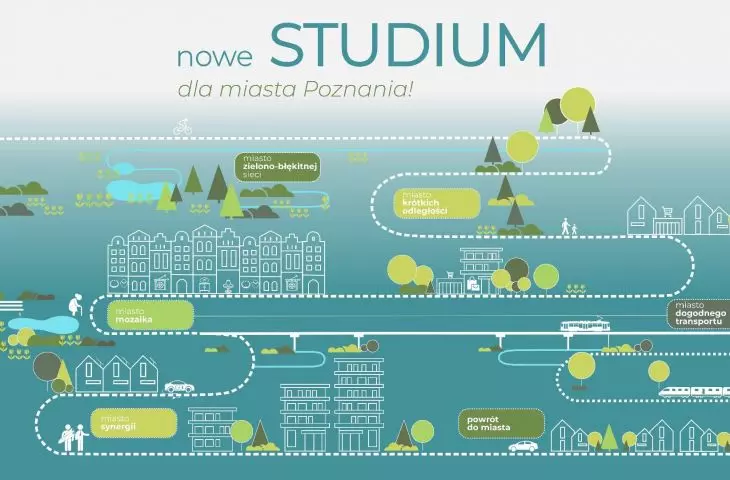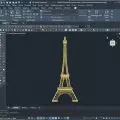In a throw-away move before the vacations, Poznań refreshed its study of land use conditions and directions. Councilors passed the document on Tuesday. There are some sensible innovations in it, but the life of the new document will not be long. It was not without controversy, either.
Work on revising the study for Poznań, as it has been in effect since 2014, has been going on for the past three years. Two aspects are key in the change. This is how they are summarized by the Municipal Urban Planning Studio, which is responsible for preparing the document:
One of the most important design goals of the new Study is to protect the city's green system on the one hand, and on the other hand, the need for development, i.e. attracting new residents to the city and enabling new investments, is also important.
green stadium and retention
How does the new study implement nature issues? The proposed way is a novelty in Poznań. It is the idea, inscribed in the study, of a coherent system of greenery implemented through connectors—that is, green „corridors” using existing and planned greenery. The city informs:
These are the most important pedestrian or bicycle routes along at least one row of trees or shrubs. They are intended to increase accessibility to green spaces.
Study of conditions and directions of development for Poznań- amendment—greenery connectors
Source: www.Poznań.pl
The City Hall, in the face of critical voices regarding nature in the city, strongly emphasizes that the new study increases the share of areas designated for greenery. Mayor Jacek Jaskowiak informs that:
Poznań, like other large cities around the world, is facing the challenges of climate change. Therefore, one of the most important objectives of the new study is to protect nature in the city.In total, green areas will occupy 413 hectares more than in the previous one.
Now green areas cover 9900.95 he ctares. Retention has also been thought of. In the document we will find indicative locations for about 200 retention reservoirs.
Studium uwarunkowań i kierunków zagospodarowania dla Poznańia- novation—board of directions
source: www.Poznań.pl
sometimes green, sometimes cut
Several pro-nature changes are also behind some of the changes councilors and community members listened to by MPU and the authorities. This includes the dynamically developing residential district of Naramowice, where—so far—the City has been stubbornly unwilling to accept an increase in green recreational areas, despite obvious shortages in this area. After a petition
signed by nearly 1,500 people and comments on the project, the study takes into account some of the demands: it secures, among other things, three hectares of greenery for the forest on Rubezh Street and part of the riparian area of the Różany Stream. In order for these provisions to become real, it is now necessary to change some of the local plans based on the existing overarching document.
Studium uwarunkowań i kierunków zagospodarowania dla Poznańia- novation—new housing developments—an example of dense development in Ostrow Tumski in the vicinity of plots of land also intended for apartments
source: www.Poznań.pl
In several significant places, however, the real existing greenery is to disappear. Residents and naturalists sought, among other things, to change the provisions of the study regarding the "Energetyk I" allotment gardens in Ostrow Tumski, north of the cathedral, behind the railroad tracks to Warsaw. However, they failed to push through the protection of the current function and—after the changes—the study still provides for, among other things, residential development there. Protests against the designation of three hectares of forest for the expansion of the Volkswagen plant in Antoninek also yielded nothing. The authorities also failed to force the abandonment of a collector road cutting a planned park in the south of Poznań in the Górczyn district. The liquidation of the gardens in Ostrow is at the same time connected with the implementation of the second very important aspect of the new study: the construction of new housing estates.
Studium uwarunkowań i kierunków zagospodarowania dla Poznańia- novation—new housing estates—areas of the new district on Darzybor intended ultimately for communal housing and SIM
source: www.Poznań.pl
apartments will fix the mistakes?
However, it is not only in such a controversial way that the study favors residential development. It allows it in several places previously occupied by the so-called „first generation” shopping centers. This is a very good move, because—firstly—there is too much large-format trade in Poznań, secondly, the aforementioned centers have just decapitated, and thirdly—they are very well located and connected, often between housing estates, in good proximity to the center, neighborhood services and green space.
The realization of these markets in such places is a mistake made in the 1990s. The construction of new housing in their place gives hope that those who moved near Poznań in the past two decades will want to return to the city. However, these intentions are overshadowed by speculative housing prices and the existing quality of the development. Local plans for these new settlements must therefore be much more restrictive than before. So that these developments constitute a decent urban fabric.
Regardless of objections or controversy over the new provisions, the latest update of the study was prepared and explained much better than during previous revisions of the document. The Municipal Urban Planning Bureau prepared well-crafted presentations with analyses and concepts. Several meetings of the Municipal Urban Planning and Architectural Commission served to familiarize its members with the proposed changes. This is how Natalia Weremchuk, director of the Municipal Urban Planning Studio, describes it:
As part of the 3-year work on the draft study, we also took into account a number of demands made by the public party already at earlier stages of its preparation. These include, for example, the preservation of greenery in the areas of Poznań forts, the transformation of Szyc Stadium into a city park, or the protection of a large area in the vicinity of Lake Kierskie from development.
Studium uwarunkowań i kierunków zagospodarowania dla Poznańia- amendment—greenery link—an example of a solution
source: www.Poznań.pl
last and for a short time?
In addition, during the work on the study—in order to facilitate orientation in the planners' approach to urban space—several keyword assumptions were introduced , peculiar direction indicators for spatial policy. Their names include "City of green and blue network,„ "City of convenient transportation,” "City of mosaic,„ "City of short distances.” However, as is well known, in order for the provisions of the study to be transformed into binding law, local development plans must be created in accordance with it. Only then do good ideas have a chance to exist in reality. There is not much time, as there are many indications that the new study will not be in force for long. This is because a major amendment to the Land Use Law is nearing completion .
After a gap of two decades, a general plan for the entire city or municipality is to return to the planning system, replacing the study and being a stronger tool than it (as local law). Aware of this, Poznań planners therefore treated the work on the new study as a fitting for the development of this plan. If the amended law comes into force in the coming months, the new general plan is expected to take effect from the end of 2025, after a two-year transition period still „served” by the study.






























